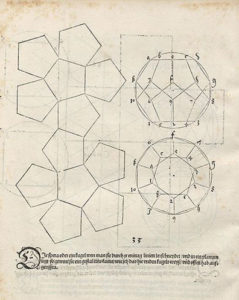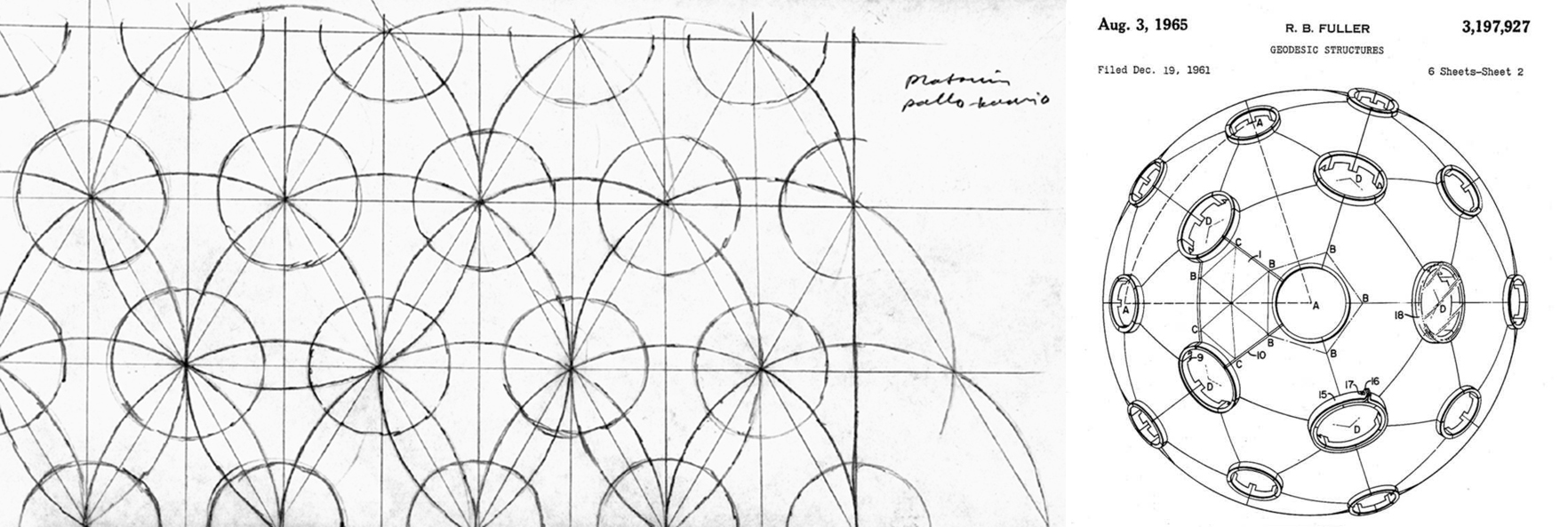
”Shape figures” presents some methods with which geometric basic shapes have been described in art and design. Further, I will tell about the analogical way of perception, which is born with paper shapes bent from a spoke. I will discuss Moebius strip twists, folding shapes from a paper spoke or string to better understand the application of basic geometry in practice.

One should have a basic understanding of geometry in connection with paper design, but traditional lessons in geometry do not lead you very far. To understand a three-dimensional shape, it has been considered important to internalise the basic shape system of the five objects that are represented by the hexahedron and tetrahedron, octahedron, dodecahedron and icosahedron appearing in the plastic education of visual art and Plato’s Euclidean geometry.
Plato was not the first to present a system about basic shapes. In 1979, Robert Lawson published the work Sacred Geometry, which combines spirituality, architecture and the proportions of man and the divine golden intersection to each other with geometry. On page 96 of the book, Lawson introduces the stone shapes of the Neolithic Age found in Scotland that replicate Platonic basic shapes. As his source, Robert Lawson has used, for example, a book by Keith Crithlow, in which he proves with those stone shapes that the Scots “invented” the so-called Platonic solids more than a thousand years before the Greeks.
Is it naive to seriously ask who invented the basic shapes and when did it happen? After all, they have been artefacts realised as geometric perception objects and related to a culture’s method of preserving its spiritual volume, whether physical or metaphysical.

Still, every competent artisan, who has weaved or processed his or her material, reed, birch bark, leather, wood, metal etc. even in Prehistoric Scandinavia has inevitably come across and noted in his or her work those same geometric basic shapes. He or she has had to admit their significance as essential basic shapes with regard to the order of the world’s matter, without which the world would not exist. Indeed, it is quite easy to fold some geometric polygons from paper. In his book Origami for the Connoisseur, Kunihiko Kasaharan presents many models and instructions for geometric folding on how Plato’s polyhedrons are folded by measuring only with a sheet of paper.

Archimedes added 13 geometric shape combinations to the basic shapes. After the Reneissance, e.g. Johannes Kepler (1571–1630) added his own polyhedrons to the collection. Still, the basic shapes of Euclidean geometry do not have to have any special position in the flexible, invisible world of structures formed from a spoke.
Indeed, we could consider that objects are formed in space from their extremities or poles, in between which straight lines can travel or around which matter curves, intertwines and thickens as substance. The angular basic shapes we know are a conventional method adopted by one culture to describe geometric shapes that are otherwise invisible. Just as the angular cube and tetra are thus basic shapes, so is the shape of a raindrop or pillow, a clam, snail, apple or even a doughnut. Reduced geometric basic shapes have during different periods fascinated and inspired designers and artists, because their beauty has nothing to do with individual talent or good taste. Their aestheticism and essence springs from mathematics and the order of nature.
Currently, for example, the German professor Martin Hess in 2005 compiled with his students an exhibition on geometric basic shapes that was comprehensive and indisputable with regard to its manner of presentation and materials in cooperation with the large German exhibition design company burkhardtleitner.com
Topology is an area of mathematics that appears in paper design. One could say that the ability by two-dimensional surfaces to form tri-dimensionality is studied in topology. Buckminster Fuller was an American architect, who studied, for example, how the shape of a ball could be approached geodesically with planes. Fullerene, i.e. a molecule of carbon that was invented in 1985, was named after him. (An image at the bottom)

Furthermore, one of the most famous topological surfaces is the so-called Moebius strip. It can be described and tested, for example, with paper strips.
What is interesting is that if one bends/flattens the surface of those three strip shapes into a plane, the first closed ring easily folds into the shape of a flat square, the second half-twisted Moebius strip folds into a flat triangle shape and the third full cycle twisted closed loop again folds into a square on the plane. If the test were continued with new loops and twists were added, all of the polygons would be achieved in order. The essence of the numbers is shown here as open and closed, or as even or uneven shapes. Shape numbers thus answer the question how many sides, folds or twists and lead from one fold to diversity.
The connection of individual basic shapes to the whole can be perceived better with this kind of continuing analogical transformation, and one can see that all possible shapes, from clams to doughnuts and sticks to tetras can fit in it, despite the manner of presentation. If a paper strip is freely twisted innumerable times, we will get a handle for a paper bag or a very durable string. So the twist make angles.

In Old Europe, two circle arcs travelling through each other’s centre points, which form a mandorla theme in the middle, are described as the Virgin Mary’s symbol. The motive can be understood to describe neutrally the beginning of life, birth or division of a cell. It also includes one of the most used paper foldings in paper design, which has been used much in e.g. head coverings.

In Asian culture, an emblem (symbolic image) describing the same thing has been the so-called Yin Yang, a double twist, from which one can continue by drawing the shape numbers of the series. The connection of individual symbols to the whole can be better perceived in this manner, and one can feel how numerical symbols have originally been connected with the mathematical unit that they are trying to describe.
